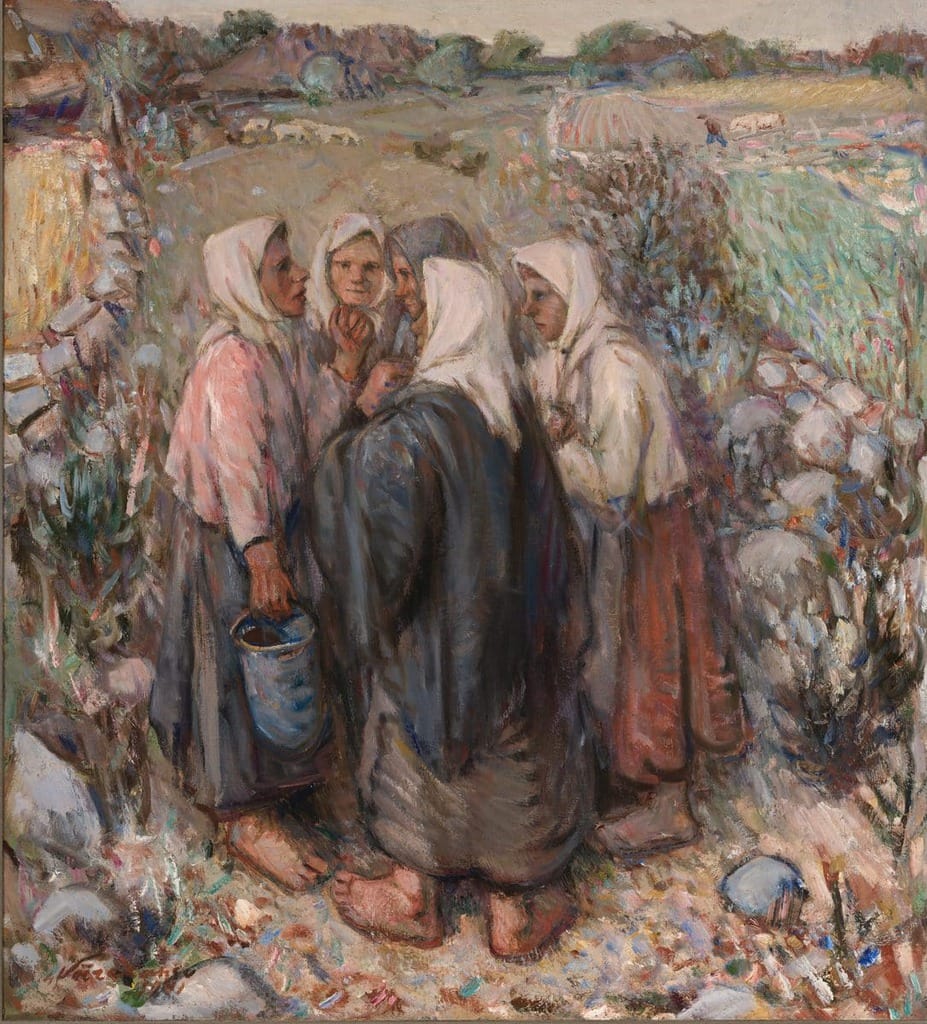
The tradition of depicting Saaremaa, Estonia’s largest island, is lengthy and associated among other things with romantic nationalist ideals. Eugen Gustav Dücker was one of the first to depict Saaremaa and Konrad Mägi, Nikolai Triik, Eerik Haamer, Johannes Võerahansu, Elmar Kits, Evald Okas, Peeter Mudist and many others continued working on Saaremaa in the 20th century. It can be said that Saaremaa is the most frequently painted place in Estonia. In addition to romantic and picturesque views (the particular diffraction of light on algae in areas near the shore, for instance, is also mentioned), the reason for this can also be considered to be nationalist moods: the Estonian mentality was created and embedded through the depiction of the landscapes of Saaremaa, tying that mentality to the harsh yet sturdy natural setting in the difficult conditions of Saaremaa.
This painting with its anecdotal plot combines rustic wretchedness and a Bacchanalia of colour in a peculiar way. Yet first and foremost, this painting is about simplicity. Unlike depicting nature, painting people always means simplification – forms and colours can be added to nature, it can be bathed in light or be deprived of it, it can be dramatised or theatricalised, but in the case of people, and especially in the case of such a painting, the only option is to reduce. People’s speech always remains unheard anyway in paintings. They are left without their primary means of expression – language – and for this reason have to establish themselves differently on the surface of a painting. Yet here as well, the art of painting is of no particular assistance because it only has a limited number of means for conveying people’s facial expressions, poses and gestures. Even Võerahansu has painted people’s faces ‘in general’. They are frozen with little detail, somewhere between a patch of colour and a face, ultimately giving us no hints on who they are, what they are talking about, or why they have gathered in the middle of the painting. Their throng can make us laugh, our fantasy starts telling us something, it seems funny how barefooted women have hurried to gather together in the middle of the workday (the pail in one woman’s hand and the farmer working in the distance indicate this) to talk about something. ‘It can’t be particularly important,’ we decide, since we do not see any drama in the painting and the women’s expressions (as much as they can be seen) are neutral. And since this is not important, then their attention, focused state, and hurrying to gather together are a little bit anecdotal. Yet beside, around and inside these reduced people here, Võerahansu has painted hundreds of colour tones. He does not reduce, instead he exaggerates. He does not withdraw, rather he adds. Grey rocks are suddenly the bearers of many different tones, blue, blackish and greenish brushstrokes have slipped in between them. As a matter of fact, recognisable motifs are scarce. Võerahansu becomes abstract time and again, colours become independent and no longer depict anything beyond themselves. The pinkish colouring of the white blouse worn by the woman with the pail in the light of the setting or rising sun is not connected in any way to a change in the blouse, but rather to a change in colour. Such a combination of reducing people and exaggerating with colours is perhaps one of the most central attributes of painting: it is impossible for you to copy reality, consequently there is no point in even trying, instead you have to create a new reality. It is not important that the village women are conversing or what they are talking about. There is nothing extraordinary or unique in this situation. The abstract vision of colours that is independent of reality is important because colours are for painting like words are for literature: a new world is built out of them.